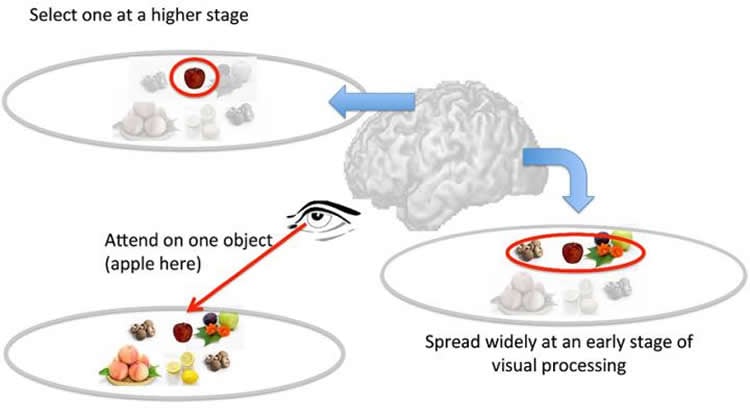Summary: A new study reveals multiple functions of visual attention.
Source: Tohoku University.
Researchers at Tohoku University have revealed multiple functions of visual attention, the process of selecting important information from retinal images.
Studies of visual attention discovered an interesting inconsistency in spatial property. Specifically, some studies reported broad spatial spreads around attended locations, while others reported a selection of information at the attention focus.
For example – according to one study, when a person looks for a friend in a crowd, visual attention makes not only the friend, but also the people standing around the friend more visible. Another study claims that attention tends to focus on the friend’s face, ignoring everyone else.
According to the research group led by Professor Satoshi Shioiri of the Research Institute of Electrical Communication, these discrepancies can be attributed to the different stages of the attention process. Their brain wave measurements revealed that a wide area around the attention focus is facilitated by attention at early visual processing, and that information at the attended location is extracted selectively at later processing. Information adjacent to the attention focus seems to be facilitated and suppressed simultaneously. So the inconsistency among previous studies can be explained by considering the effects of different attentional processes.

The research group thus proposes a model of spatial attention that has two stages with different functions. The attention model proposed could predict different attention effects for different visual processes.
This would be useful particularly for complex tasks such as driving, where it is important to notice not just pedestrians but also other elements on the road. Precise estimation of attention helps people to understand potential dangers in attention-demanding conditions.
Source: Satoshi Shioiri – Tohoku University
Image Source: NeuroscienceNews.com image is credited to Satoshi Shioiri.
Original Research: Full open access research for “Visual attention spreads broadly but selects information locally” by Satoshi Shioiri, Hajime Honjyo, Yoshiyuki Kashiwase, Kazumichi Matsumiya and Ichiro Kuriki in Scientific Reports. Published online October 19 2016 doi:10.1038/srep35513
[cbtabs][cbtab title=”MLA”]Tohoku University. “How Visual Attention Selects Important Information.” NeuroscienceNews. NeuroscienceNews, 14 November 2016.
<https://neurosciencenews.com/visual-attention-information-5503/>.[/cbtab][cbtab title=”APA”]Tohoku University. (2016, November 14). How Visual Attention Selects Important Information. NeuroscienceNews. Retrieved November 14, 2016 from https://neurosciencenews.com/visual-attention-information-5503/[/cbtab][cbtab title=”Chicago”]Tohoku University. “How Visual Attention Selects Important Information.” https://neurosciencenews.com/visual-attention-information-5503/ (accessed November 14, 2016).[/cbtab][/cbtabs]
Abstract
Visual attention spreads broadly but selects information locally
Visual attention spreads over a range around the focus as the spotlight metaphor describes. Spatial spread of attentional enhancement and local selection/inhibition are crucial factors determining the profile of the spatial attention. Enhancement and ignorance/suppression are opposite effects of attention, and appeared to be mutually exclusive. Yet, no unified view of the factors has been provided despite their necessity for understanding the functions of spatial attention. This report provides electroencephalographic and behavioral evidence for the attentional spread at an early stage and selection/inhibition at a later stage of visual processing. Steady state visual evoked potential showed broad spatial tuning whereas the P3 component of the event related potential showed local selection or inhibition of the adjacent areas. Based on these results, we propose a two-stage model of spatial attention with broad spread at an early stage and local selection at a later stage.
“Visual attention spreads broadly but selects information locally” by Satoshi Shioiri, Hajime Honjyo, Yoshiyuki Kashiwase, Kazumichi Matsumiya and Ichiro Kuriki in Scientific Reports. Published online October 19 2016 doi:10.1038/srep35513






